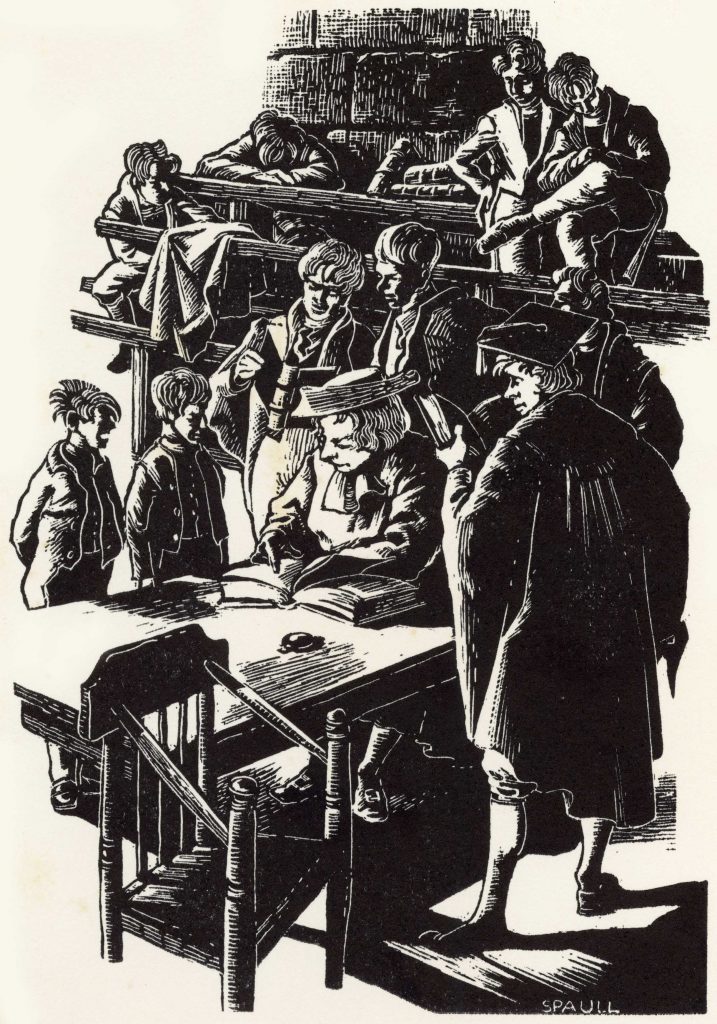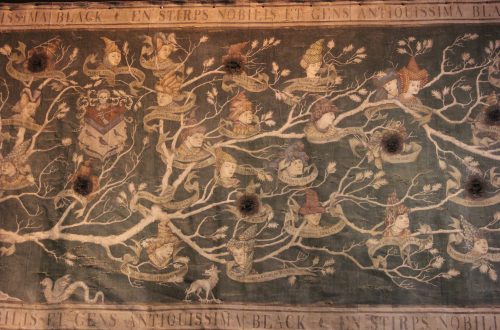This year we will be starting a new feature on our twitter feed @WSchoolArchives, Challenge Tuesday. We will be tweeting questions from over 150 years of scholarship examination papers, which provide a fascinating insight into changing expectations.
‘The Challenge’ is the intimidating name of our scholarship examination. Following the dissolution of the Monastery at Westminster Abbey, Henry VIII established a new foundation at Westminster School, stating that forty scholars should be taught grammar by two masters. Elizabeth I’s statutes, given in 1560, reaffirmed this tradition:
‘The scholars shall be 40 in number, and we wish that in selecting them the greatest weight be given to gentleness of disposition, ability, learning, good character and poverty; and insofar as any one candidate excels in the possession of these qualities, he shall, as is proper, be preferred.’

A procedure for ‘electing’ these scholars was also established in the statutes, in which candidates would be examined ‘as to their ability in grammar, literature, and writing…in open session’. It was also established that a pupil should have attended the school for a year before becoming a ‘minor candidate’ for ‘election’ into College, the Scholars’ boarding house. This enabled the school to grow, and by the 17th Century there were significant numbers of pupils who were members of Westminster School, but who had no intention of becoming Scholars. Pupils at the school who were not scholars became known as ‘Town Boys’.
Interestingly, two other prescriptions in the Elizabethan statutes seem to have been ignored, almost from the outset. One stated that ‘no more than one scholar be elected or admitted from the same county at any one election’ and the other that ‘no heir, and no-one who will become heir on the death of his father, shall be elected if the value of his inheritance exceeds ten pounds.’ Scholars did often originate from a variety of counties; the Abbey owned land across the country and through its connections bright pupils could be recommended to the school. However, the demand that each scholar at each election should be from a different county must have proven too difficult to apply. We also know, for example, that in the 1560s the son of the wealthy Sir Nicholas Bacon, Lord Keeper of the Great Seal, was admitted as a scholar and whilst some candidates met the criteria of ‘poverty’, others decidedly did not! As the value of money over the ensuing years changed drastically, the value of the scholarship was reduced, until at one point in the 19th Century the cost of a Scholar’s education was nearly, if not quite, equal to that of a Town Boy. However, the scholarships remained a good investment, as they enabled pupils to apply for one of several valuable closed scholarships to Trinity College, Cambridge or Christ Church, Oxford, a scheme also established by Elizabeth I.
The competitive nature of the election procedure for Scholars did have one important effect. In other public schools, pupils who held foundation scholarships were often looked down on by their peers as being of a lower class. For the sons of aristocratic families applying for a scholarship at Eton, for example, would have been unthinkable, whilst applying for the scholarship at Westminster was a different matter altogether. At Westminster, Scholars and Town Boys were seen largely as equals. Indeed, the keen competition for the scholarships, combined with the Head Masters’ tendencies to give the scholars pre-eminence in the running of the school, confirmed a prestige on the role.
Originally the examination of ‘minor candidates’, the prospective scholars, was undertaken by the Electors – the Master of Trinity and Dean of Christ Church- when the latter were visiting the school to select ‘major candidates’ for their own institutions. However, by the 18th Century the process of selecting scholars had developed into an arduous oral examination, overseen by the Head Master which would take place daily for a period of several weeks. It became known as ‘The Challenge’ as it took on an adversarial format – that is to say that pupils were in direct competition to win their place as a scholar. Often around 20-30 candidates would put themselves forward for the scholarships and they were roughly ranked in order of ability by the masters. The bottom two boys of the list of minor candidates for that election would start the process
Henry George Liddell (Head Master 1846-1855) explains:
‘The two lowest boys came up before the Head Master, having prepared a certain portion of Greek epigram and Ovid’s Metamorphoses, which had been set them a certain number of hours before. In preparing these passages they have the assistance of certain senior boys, who are called their Helps. The lower of the two boys is the Challenger. He calls on the boy whom he challenges to translate the passage set them, and, if he can correct any fault in translating, takes his place. The Upper boy now becomes the Challenger, and proceeds in the same way. When the translation is finished the Challenger, whichever of the two boys happens to be left in that position, has the right of putting questions in grammar; and, if the Challengee cannot answer them and the Challenger answers them correctly, the former loses his place. They attack each other in this way until their stock of questions is answered. The first Challenge is called the Unlimited Challenge, in which they may ask any number of questions they like. These questions are all in grammar, and sometimes the boys are so well prepared that I have known two boys go on until 9 o’clock at night, having begun early in the morning. After this Unlimited Challenge, by which a clever boy who is low in the list may get to the top, what is called the Limited Challenge began, in which the questions are limited to a certain number, the Challenge ceasing after these questions were exhausted.’
The whole Challenge could take six to eight weeks to complete in its entirety. At the end, the pupils who had reached the top of the list would be selected for the available scholarships, the number varying year on year depending on how many vacancies had been created by scholars leaving the school. Existing scholars would have a chance to earn some money by acting as ‘helps’ to up to three minor candidates, charging a fee of ten guineas per pupil and receiving a bonus of fifteen guineas should one of their charges obtain the top position.
In 1856 a written paper was introduced in addition to the oral Challenge, and, before long, the tradition had died out altogether. Originally the written papers tested only Latin and Greek, but soon additional subjects were added. The requirement that pupils sitting the examination should have been members of the school for a year before taking the paper was also dropped. Finally, in the late 20th Century, the Greek paper was made optional, so as not to discriminate against pupils who had not yet had a chance to learn the language.
Whilst today, The Challenge does not require quite the same stamina of pupils, it is still an exacting examination. The questions are deliberately difficult as they seek to differentiate between over one hundred pupils. Each year the top eight are selected for the honour of a Queen’s Scholarship and their names are printed in the newspaper and posted on a notice board outside of the school. Up until recently the pupils were listed in their rank order, from 1st scholar to 8th. Today the scholarships represent 50% of the schools full boarding fee. From 2017 one further change will be made – girls joining the school at 16+ will have the chance to be elected scholars and join College.



